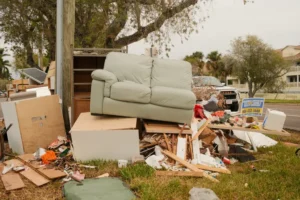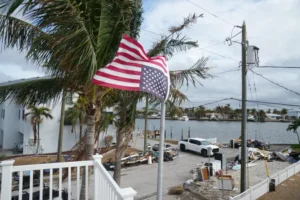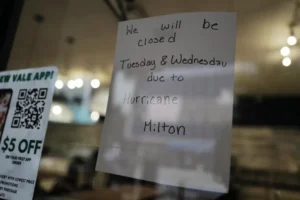As Hurricane Milton moves toward Florida’s Gulf Coast, people are preparing for what experts say could be the worst storm in over 100 years. With huge storm surges and strong winds expected, the region is on high alert, and evacuation orders are being issued.
Hurricane Milton is gaining strength fast, and experts warn it could be one of the most dangerous storms in recent times. Many areas are already vulnerable due to past storms, increasing the risk of widespread damage and flooding.
Evacuation orders are in place, and officials are urging people to take the storm seriously and prepare for life-threatening conditions. Safety is the main focus as the storm approaches, and the next few days will be crucial for those in its path.
### Hurricane Milton: A Record-Breaking Storm
Hurricane Milton has grown into a Category 5 storm, one of the most dangerous types on the Saffir-Simpson scale. With winds over 157 mph, it could cause massive destruction along its path.

The National Hurricane Center warns that homes could be destroyed, trees and power lines will fall, and some places might not be livable for weeks or even months. They said, “A high percentage of framed homes will be destroyed, with total roof failure and wall collapse.”

Storm surges could be especially bad, with water levels rising up to 12 feet in some areas. This could be the worst surge the Tampa Bay area has seen in nearly 100 years. Just weeks ago, Hurricane Helene caused floods with an 8-foot water surge.
Milton is expected to bring even worse flooding. While the storm may weaken to a Category 3 by the time it hits Florida, it will still be dangerous. With winds up to 129 mph, even strong homes could suffer major roof damage, and trees are likely to be uprooted.

Many are comparing Milton to past hurricanes like Irma (2017) and Betsy (1965). But what makes Milton particularly dangerous is the debris left behind by Hurricane Helene, which could worsen the damage.
### Warnings from Officials: The Call to Evacuate
As the hurricane nears, local authorities are giving strong warnings to people in at-risk areas. Tampa Mayor Jane Castor warned, “[If you] stay in one of those evacuation areas, you’re gonna die.”

She said that while past storms like Hurricane Helene were bad, Milton could bring destruction on a whole new level. Pinellas County Sheriff Bob Gualtieri echoed this, calling for the largest evacuation since Hurricane Irma in 2017.
“This is going to be bad. Everyone just needs to get out,” he said. Governor Ron DeSantis also spoke of the risks, saying, “There are areas with a lot of debris… if hit by a major hurricane, it’s going to dramatically increase damage.”

Evacuation orders are in place, and local authorities stress that those who don’t leave will be on their own when the storm hits. Many who stayed behind in past hurricanes are now taking these warnings seriously.
### Evacuation Efforts in Full Swing
With Hurricane Milton approaching Florida’s Gulf Coast, evacuation efforts are in motion. Local authorities have ordered mandatory evacuations for several coastal communities, urging people to leave before it’s too late.

Traffic is heavy on highways as thousands of residents move inland to escape the storm. On Interstate 75, northbound lanes were packed with cars heading toward the Florida Panhandle.
Others sought shelter in places like Fort Lauderdale and Miami, which are expected to be less affected. Meanwhile, southbound lanes were nearly empty. Communities hit hard by past storms aren’t taking chances this time.

In Fort Myers Beach, a town devastated by Hurricane Ian two years ago, streets were empty as residents packed up and left, with only a few people staying behind to secure their homes.
Those who remember the severe flooding caused by Ian’s 15-foot storm surge know the danger is real and are taking steps to avoid a repeat of past tragedies.
As Hurricane Milton nears, people in high-risk areas need to know their evacuation zones and routes. The Florida Division of Emergency Management has a “Know Your Zone” tool, helping residents find their zone by entering their address.

This tool is especially important as evacuation orders continue to come for coastal areas along the Gulf Coast. Several counties are advising residents to check both their evacuation and storm surge zones.
Counties like Hillsborough, Pinellas, Manatee, and Pasco have issued immediate evacuation orders for areas most at risk. Coastal communities in these regions must evacuate quickly.

Other counties, like Polk and Highlands, don’t have mandatory evacuations but recommend sheltering in place. Sarasota, Citrus, and Hernando counties are also monitoring storm surge zones for possible evacuations.
Officials emphasize the importance of knowing your evacuation zone and finding the nearest shelters and safe routes. Those who stay may face the full force of the storm, with emergency services likely unavailable once conditions worsen.

The “Know Your Zone” map offers an easy way for residents to plan their safest escape route. By using this resource and acting quickly, people can protect themselves and their families from Hurricane Milton’s potential devastation.
Girl, 6, dies in freak badminton accident – wanted to be ‘saved’

A New Jersey family is mourning the tragic loss of their 6-year-old daughter, Lucy Morgan, who died in a freak accident while on vacation.
The incident occurred while Lucy was watching her family play badminton
During the game, a racquet suddenly broke during a downward swing, and a piece of metal from the handle snapped off, striking Lucy in the skull and causing a catastrophic brain injury.
Lucy’s father, Pastor Jesse Morgan, shared the heartbreaking details on his blog, New Creation Living. He recounted how June 1 started like any other day during their family vacation in Limerick, Maine. However, the day took a fateful turn, and now he believes his little girl is with Jesus.
The family quickly realized the severity of Lucy’s injury. Jesse explained on his blog that after the metal piece struck Lucy, she was immediately unresponsive but was still breathing on her own. His wife, Bethany Morgan, accompanied Lucy in the ambulance to a small hospital before she was airlifted to Maine Medical Center in Portland. They knew Lucy’s life was in grave danger.

“Upon arrival she went right to the operating room where they removed part of her skull to relieve pressure and deal with her injury. She coded, they got her back, and they completed the surgery,” Jesse wrote on his blog. “In the PICU we are being told that there is a very slim chance she recovers.”
Jesse Morgan shared that his daughter had recently expressed a desire to be with God. Just a month before the accident, Lucy told her parents she wanted to be saved and live with God. Jesse wrote that Lucy asked her mother about being saved, and after a brief conversation, she went to her room to pray.
“She went to her room and prayed to God to forgive her and that she believed in Jesus’ death and resurrection. What a gift,” he wrote.
Despite the medical efforts, Lucy never recovered from her injury. Jesse explained that the metal piece had caused devastating damage due to where it pierced her skull. Doctors informed the family that she would likely not survive.
The day before her death, he wrote, “The significant lack of brain function over the past 48 hours demonstrates this reality that we are utterly devastated by. If there is any good news in this, it’s that she hasn’t felt any pain over the past few days.
“We will keep waiting on the Lord, getting second opinions, and exhausting every possible avenue while crying out to God for a miracle,” he added. “However, as of now, our beloved daughter has been showing all the signs of brain death for the past few days. There is a very good chance that she passes away and meets Jesus within 24 hours.”
In the wake of this tragedy, the family has been surrounded by love and support. Many people took to social media to share kind words about Lucy and her family. Dan Cruver, a former professor of Jesse Morgan, spoke highly of Jesse’s character in a Facebook post.
“Jesse Morgan was a student of mine when I taught Bible and theology at Clarks Summit University 18 years ago. I remember quite a lot of students, but there are a few that you remember because they frequently engaged you after class and asked thoughtful, insightful questions,” he wrote. “Jesse was one of those students.”
To support the family, loved ones created a GoFundMe account which has surpassed its original goal of $100,000 and is nearing a new goal of $130,000, with more than $125,000 in donations so far.
Organizer Jill Anthony wrote, “This page serves as a place to provide them extravagant financial support – to help pay for meals while they are away from home, lodging for family, medical costs … whatever they need.”
Anthony added an update: “June 5, Lucy went to be with the Lord. Please keep praying for the Morgans as they walk through these next days, weeks, months, and years without their sweet Lucy here with them.”



Leave a Reply